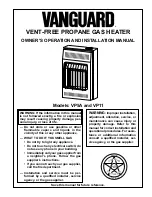
www.
hotwater .com 37
To Re
fi
ll The Water Heater Storage Tank
1. Close the water heater drain valve.
2. Remove the drain hose.
3. Open a nearby hot water faucet and leave open to
allow air to escape.
4. Open the cold water inlet valve to the water heater.
5. To purge the lines of any excess air, keep the hot
water faucet open for 3 minutes after a constant
fl
ow
of water is obtained.
6. Turn “ON” the gas supply at the manual gas shut-off
valve.
7. Follow the lighting instructions on the label or see
“Lighting Instructions” to restart the water heater.
To Flush The Water Heater Storage Tank
1. Turn “OFF” the gas at the manual gas shut-off valve
(see Figure 1).
2. Ensure the cold water inlet valve is open.
3. Connect a hose to the drain valve and terminate it to
an adequate drain.
4. Ensure the drain hose is secured before and during the
entire
fl
ushing procedure. Flushing is performed with
system water pressure applied to the water heater.
5. Open the water heater drain valve to
fl
ush the storage
tank. Caution: Water will be hot.
6. Flush the water heater storage tank to remove
sediment and allow the water to
fl
ow until it runs clean.
7. Close the water heater drain valve when
fl
ushing is
completed.
8. Remove the drain hose.
9. Ensure the heater is full of water.
10. Turn “ON” the gas supply at the manual gas shut-off
valve.
11. Follow the lighting instructions on the label or see
“Lighting Instructions” to restart the water heater.
12. Allow the water heater to complete several heating
cycles to ensure it is operating properly.
Caution:
Do not turn on the gas to the water heater
unless the tank is full. Open a hot water faucet and allow
the water to run until the air is purged and the water
fl
ows
uninterrupted from the faucet.
Important:
When operating a cold tank, condensation can
occur and drip on the burner. This should not be confused
with a tank leak.
DRAIN VALVE WASHER REPLACEMENT
1. Turn “OFF” the gas at the manual gas shut-off valve
(see Figure 1).
2. Follow “Draining” instructions in the “Draining, Re
fi
lling
And Flushing” section.
3. Turning counterclockwise ( ), remove the hex cap
below the screw handle.
4. Remove the washer and put the new one in place.
5. Screw the handle and cap assembly back into the
drain valve and retighten using a wrench. DO NOT
OVER TIGHTEN.
6. Follow
“Re
fi
lling” instructions in the “Draining, Re
fi
lling
And Flushing” section.
7. Check for leaks. Repair as needed.
8. Follow the lighting instructions on the label or see
“Lighting Instructions” to restart the water heater.
HANDLE AND
CAP ASSEMBLY
ALTERNATIVE
STEM HANDLE
WASHER
Figure 41
ANODE ROD MAINTENANCE
Each water heater contains at least one anode rod,
which will slowly deplete (due to electrolysis) prolonging
the life of the water heater by protecting the glass-lined
tank from corrosion. Adverse water quality, hotter water
temperatures, high hot water usage, hydronic heating
devices, and water softening methods can increase
the rate of anode rod depletion. Once the anode rod
is depleted, the tank will start to corrode, eventually
developing a leak.
Certain water conditions will cause a reaction between the
anode rod and the water. The most common complaint
associated with the anode rod is a “rotten egg smell”
produced from the presence of hydrogen sul
fi
de gas
dissolved in the water. See “Operational Conditions”.
Important:
Do not remove this rod permanently as it will
void any warranties. A special anode rod may be available
if water odo r or discolo ration occurs.
CAP
ANODE ROD *
* THE ANODE ROD IS COVERED
BY URETHANE FOAM LOCATED
UNDER THE CAP. CHIP AWAY
THE FOAM TO EXPOSE THE
TOP OF THE ANODE ROD
Figure 42












































